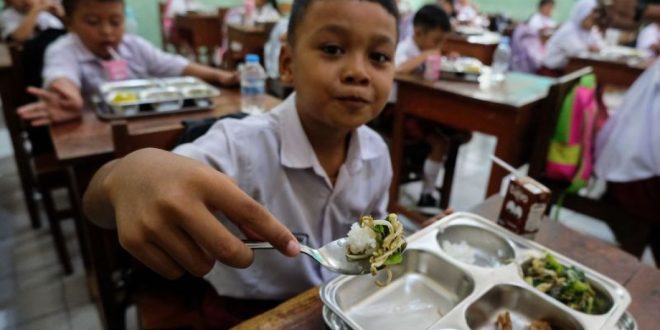Indonesia’s ambitious free meals program is poised to make a significant impact on the nation’s children. By providing nutritious meals in schools, the program aims to combat malnutrition, improve dietary habits, and ultimately foster a healthier future generation. This initiative is expected to address not only immediate nutritional needs but also establish long-term positive dietary patterns among Indonesian children, contributing to their overall well-being and academic performance. It’s a pretty big deal, actually, because a healthy kid is a happy kid, right? And a happy kid learns better. So, let’s dive into what this program is all about!
The Rationale Behind the Free Meals Program
Addressing Malnutrition and Stunting
Malnutrition and stunting are, unfortunately, pretty prevalent issues among Indonesian children. You might be wondering why this is so important. Well, malnutrition can lead to serious health problems and hinder a child’s growth and development. Stunting, in particular, affects not just physical growth but also cognitive abilities. The free meals program is designed to directly tackle these problems by ensuring kids get the nutrients they need. I mean, imagine trying to concentrate in class when your tummy’s rumbling and you’re not getting enough vitamins. It’s just not fair, is it?
Improving Access to Nutritious Food
One of the core goals of this program is to level the playing field. It aims to make sure that children from low-income families have access to healthy, balanced meals that they might not otherwise get at home. How does it do that? By providing these meals right where the kids are – at school. It’s a simple idea, really, but it can have a massive impact. Think about it: a kid who knows they’ll get a good meal at school can focus on learning instead of worrying about where their next meal is coming from. That’s a game-changer!
Program Implementation and Logistics
Meal Planning and Nutritional Guidelines
This isn’t just about slapping some food on a plate. A lot of thought goes into planning these meals. Nutritional experts are involved in creating menus that meet the specific dietary requirements of different age groups. It’s all about making sure the kids get a balanced diet with the right amount of protein, vitamins, and minerals. So, what kind of food are we talking about? Well, you can expect a variety of options that are both nutritious and appealing to kids. Because let’s be honest, if the food doesn’t taste good, they’re not going to eat it, are they?
Supply Chain and Food Sourcing
Sourcing all that food? It’s a Herculean task. The program is focused on sourcing food in a way that’s both high-quality and sustainable. That means working with local farmers and suppliers whenever possible. It boosts the local economy, too. There’s also a big emphasis on food safety. You wouldn’t want any little tummies getting sick, after all. Ensuring a reliable and safe food supply is critical to the program’s success. Gotta make sure everything’s tip-top!
Distribution and Monitoring
Getting the meals from the kitchen to the kids involves some pretty impressive logistics. The program is set up to distribute meals efficiently to schools across Indonesia. But it doesn’t stop there. There are also monitoring mechanisms in place to ensure the program is running smoothly and that the meals are being properly prepared and served. It’s like having quality control, but for school lunches! This helps catch any problems early on and make sure the kids are actually benefiting from the program.
Expected Impact on Child Nutrition
Improved Nutritional Intake
The hope is that this program will lead to a significant increase in the amount of essential nutrients that children are consuming. We’re talking about vitamins, minerals, and all the good stuff that kids need to grow up healthy and strong. And when kids get the nutrients they need, they’re less likely to get sick and more likely to thrive. It’s kind of a no-brainer, isn’t it? The idea is that the free meals program will give child nutrition a much-needed boost.
Positive Changes in Dietary Patterns
Beyond just providing nutrients, the program also aims to promote healthier eating habits. By offering balanced meals, it’s hoped that kids will develop a taste for nutritious foods and reduce their consumption of unhealthy stuff like sugary snacks and processed junk. After all, habits start young. If you can get kids eating healthy early on, they’re more likely to stick with those good habits for life. It’s like planting a seed that grows into a lifetime of healthy choices.
Long-Term Health Benefits
The benefits of good nutrition extend far beyond childhood. Kids who eat healthy are less likely to develop chronic diseases like diabetes and heart disease later in life. So, the free meals program isn’t just about helping kids today; it’s about investing in their future health and well-being. It’s about giving them the best possible start in life so they can grow up to be healthy, productive adults. It’s the kind of thing that makes you feel all warm and fuzzy inside, doesn’t it?
Potential Challenges and Mitigation Strategies
Financial Sustainability
Let’s be real – a program of this scale requires a lot of funding. One of the biggest challenges is ensuring its long-term financial sustainability. It will probably require innovative funding models, partnerships with private organizations, and a strong commitment from the government. Gotta keep that money flowing! It’s a huge hurdle, but overcoming it is essential to making the program a lasting success.
Logistical Hurdles
Distributing meals to schools across a vast archipelago like Indonesia? It’s not exactly a walk in the park. There are bound to be logistical challenges related to transportation, storage, and infrastructure. But where there’s a will, there’s a way, right? Potential solutions could include investing in better transportation networks, establishing regional food hubs, and working with local communities to overcome these hurdles.
Community Engagement
You can’t just roll out a program like this from the top down and expect it to work. Community involvement is crucial. It’s all about getting parents, teachers, and local leaders on board and making them feel like they’re part of the solution. This might involve holding community meetings, providing educational resources, and actively seeking feedback. If everyone works together, the program has a much better chance of succeeding.
The free meals program in Indonesia has the potential to really transform child nutrition and dietary patterns. By tackling malnutrition, promoting healthy eating habits, and investing in the long-term health of Indonesian children, this initiative could pave the way for a healthier and more prosperous future. Seems like a pretty good investment, if you ask me. What do you think? I’m curious to see how it all unfolds. Hopefully, it’s as successful as we’re all hoping for!
 Beverage Zone
Beverage Zone




